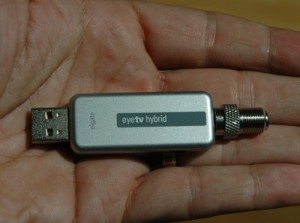 The elgato EyeTV Hybrid is a beautiful little USB 2.0 TV Tuner for Mac or Windows computers. It’s “hybrid” in that it will tune just about anything you’ve got: analog cable/tv, Digital/HDTV, and Clear QAM digital cable. It even has adapters so you can hook up a Composite or S-Video source (such as an analog camcorder) to capture standard definition video. The EyeTV is fully supported without additional drivers under Windows 7, via Windows Media Center. If you’re a Mac, the included EyeTV 3 software enables viewing and recording for you.
The elgato EyeTV Hybrid is a beautiful little USB 2.0 TV Tuner for Mac or Windows computers. It’s “hybrid” in that it will tune just about anything you’ve got: analog cable/tv, Digital/HDTV, and Clear QAM digital cable. It even has adapters so you can hook up a Composite or S-Video source (such as an analog camcorder) to capture standard definition video. The EyeTV is fully supported without additional drivers under Windows 7, via Windows Media Center. If you’re a Mac, the included EyeTV 3 software enables viewing and recording for you.
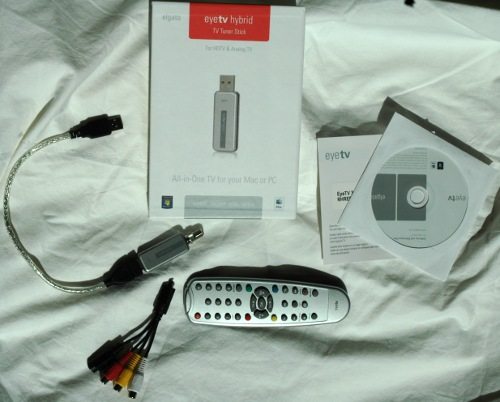
The photo above shows you everything in the box: the EyeTV receiver, a USB extension cable, the breakout cable for connecting analog sources, Mac software, and the IR Remote. For the review I set the EyeTV up on a couple Windows Laptops (an HP “entertainment” class laptop with Core 2 Duo CPU and Windows 7 Home Premium, and an Acer Aspire One netbook with 2GB ram, running Windows 7 ultimate) and one MacBook.
A Closer Look
Before we get to the nuts and bolts, let me show you the reviver and remote up close.
The device itself is roughly the size of your average USB memory stick. The large antenna/coax adapter on the right is often not shown in promotional/web shots on the elgato web site, but the review unit arrived with it attached and I wasn’t able to remove it with gentle tugging. Not that you can use it with it removed, anyway – but we’ll get back to that later.
On the right edge is the dongle port. The left edge has the IR receiver for the remote.
The remote is one of those standard gray slabs we all know and love. I did not verify this, but I expect the IR codes used are compatible with/the same as Hauppauge-based tuners/remotes, so it may be fairly simple to use a universal remote.
Setup/Install (Windows 7 Media Center)
This isn’t a review of Windows 7 or the Windows Media Center, so I’m going to breeze through this pretty quickly. If you have any version of Windows 7, you should have (or can install) Windows Media Center. Getting the EyeTV to work with WMC is a two step process. First, insert the USB receiver. Wait for Windows to install the drivers, which it should do automagically:
After a while, Windows will tell you it’s ready to use. Fire up WMC and it will walk you through the configuration for your TV source. One of the many many windows you will see is:
This is showing that, when plugged into my very large HDTV antenna coax cable (we’ll get back to that at the end, I promise!) WMC and the EyeTV agree that they can see lots of HDTV over the air channels. Very promising! Continuing on for another few setup screens finally leads to victory:
The EyeTV remote is fully supported under WMC and, assuming you can see the dongle itself with the remote, works fine from normal “couch” distance of 6-10 feet.
I tuned to a couple of HD channels and verified that both 720p and 1080i HDTV works fine. Windows 7 can’t take a screen shot of a full-screen video overlay, so first here is a shot of PBS in a window.
I captured a few seconds of our local NBC and ABC stations to get 1080i and 720p video. A small clip of the ABC nightly news (720p) is available here. Below are two frames from recordings made in WMC with the EyeTV of 1080i and 720p programs:
As expected, digital TV captures (and live viewing) work beautifully.
Setup/Install (Mac – EyeTV 3)
Phyiscal installation on the Mac is identical. Plug in the USB tuner. On the Mac you’ll need to install the EyeTV 3 software to get to the point of viewing/recording video. Installation went without a hitch:
As in the case with Windows, the setup detects the device and walks you though setting up/detecting channels, and determining what guide you should be using based on your service. I used the same Digital over the air antenna, and (not surprisingly!) found the same channels. After a few setup screens, success again:
As with Windows, the EyeTV remote fully controls the software. You can also use your Mac remote, if your Macintosh has one.
EyeTV 3 DVR
The EyeTV 3 software is a full featured DVR, with built in program guide, scheduler, series recorder, and timeshifting/pausing live TV. It performed as expected during the review. Navigation via the keyboard, on screen remote, or physical remote was straightforward, and the software worked equally well in windowed mode (in case you wanted to work with the TV on in the background) or in full screen mode.
In full screen mode, the on-screen remote disappears after a few seconds. It pops back up if you move the mouse (that’s why its in all my screen shots!) but it does go away if you’re using the IR remote.
You can change settings in full screen mode as expected. For example, let’s get subtitles going.
Subtitles are Muy Bueno:
I was able to record digital sources even on a very underpowered Macbook without difficulty. A small clip from the opening of a world cup game, recorded via EyeTV 3, is available here. I actually don’t have any analog sources left in the house to test the analog recording, but it clearly states on the elgato site that analog recording is encoded as mpg2 via software, and not on the EyeTV hardware itself. This shouldn’t be a problem for any Mac with a Core 2 or better CPU.
Tuning, Antennas and Other Small Details
As promised, this is my big problem with this nifty little adapter. Without a fairly decent sized antenna, or a Cable TV source, you’re not going to be seeing anything with it. It seems silly to have to point that out, but you could get the impression that an antenna isn’t needed. What you have here is a really small TV tuner. Depending on where you live (or where you want to watch TV) you’ll need anything from a small set-top antenna to a large rooftop one. I went through this dance in the early 2000s when I got my first HDTV – before the digital transition, and before Comcast even offered HD. From my home to the big HDTV broadcast tower in San Fransisco, I needed not only a full-sized rooftop antenna, but also a 10 foot poll to mount onto the chimney, to put it up high enough. From there, I got a great signal. Fast forward to 2010, and Comcast gives me all the HD I want. The antenna still sits, neglected, on the roof.
When the EyeTV arrived for review I tried it naked, with no antenna, and as I expected got no channels at all. Plugging into that monster on the roof got me upwards of 40 digital channels. I also had a Winegard SS-3000 indoor amplified antenna handy (I seem to collect antennas) and sure enough, it only pulled in the closest couple of stations from inside my house – and it’s nearly three feet across.
So, what’s this mean to you? If you’re expecting this EyeTV to get a picture over the air with no antenna, forget it. Unless you are sitting under the broadcast tower, you are going to need some kind of HDTV/Digital antenna. If you need a big antenna, then that’s going to limit your portability much more than the EyeTV tuner itself.
So, what do you gain from the portability of the EyeTV? Well, if we lived in an analog world, being able to take a small analog capture device with you might be quite handy. I’m not sure that the need to capture analog video comes up much these days, but if you have that need this is a great device for that. Also, it’s possible you’d like to add digital recording to a device that doesn’t support internal expansion. Certainly this is true for many Macs, and for any Laptop device. Being able to set up a system for casual recording, or for regular recording/viewing via the EyeTV is fast, simple, and once completed doesn’t require much more than plugging in (or pulling out) a USB cord.
Conclusion
The EyeTV Hybrid is a good, small TV Tuner/Video capture device. It’s ability to tune and hold a channel lock is comparable to that of “full sized” external or expansion card-based tuners, and it works equally well for Mac and PC based machines. The USB-based device is ideal for all-in-one machines, Laptops, and even Netbooks. If you’re buying the EyeTV for a Windows machine, you’ll pay a premium over Windows-only USB tuners since you’re also paying for the Mac EyeTV 3 software.
Out of the box you’re not given everything you need to watch over-the-air TV, and from personal experience getting an internal antenna to work even from the near-in suburbs can be tricky, so be sure you understand the requirements for an antenna, or a cable box, before you decide the EyeTV is for you.
ESR for MagSafe Wallet with Stand, RFID Blocking with MagSafe Ring, 5 Card Holder for Phone Case, Slim Leather Magnetic Wallet for iPhone 17/16/15/14/13/12 Series(Not for Mini), Selected Samsung,Black
33% OffTANGEM Wallet Pack of 2 - Secure Crypto Wallet - Trusted Cold Storage for Bitcoin, Ethereum, NFT's & More Coins - 100% Offline Hardware Wallet
$54.90 (as of January 7, 2026 13:03 GMT -06:00 - More infoProduct prices and availability are accurate as of the date/time indicated and are subject to change. Any price and availability information displayed on [relevant Amazon Site(s), as applicable] at the time of purchase will apply to the purchase of this product.)Product Information
| Price: | $149.95 |
| Manufacturer: | elgato |
| Requirements: |
|
| Pros: |
|
| Cons: |
|

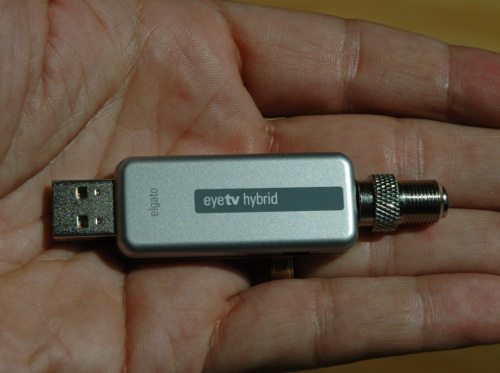
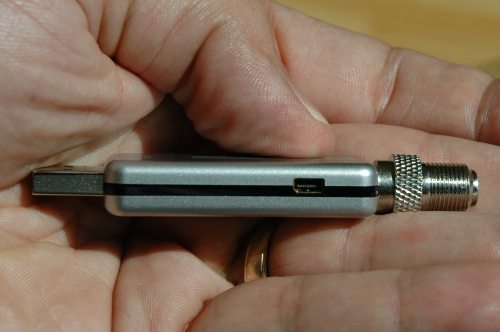
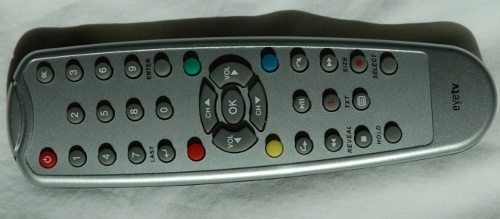
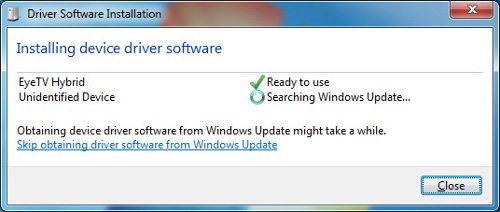
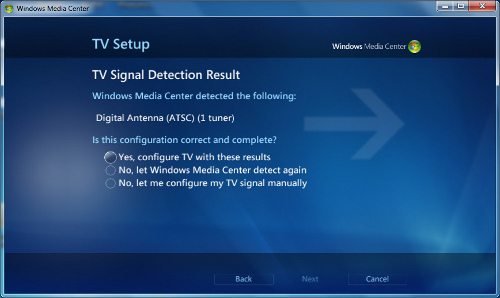
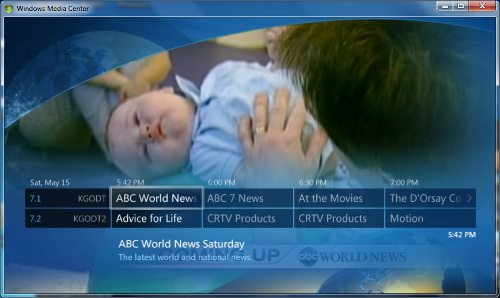
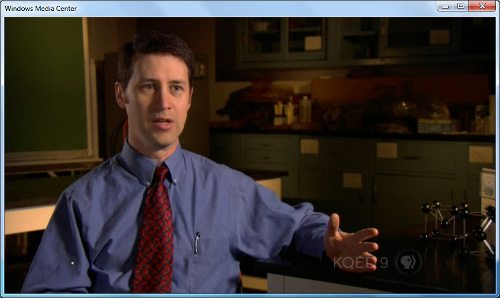


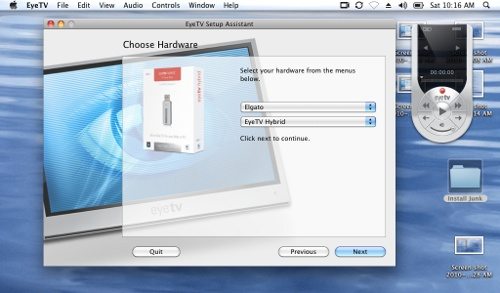
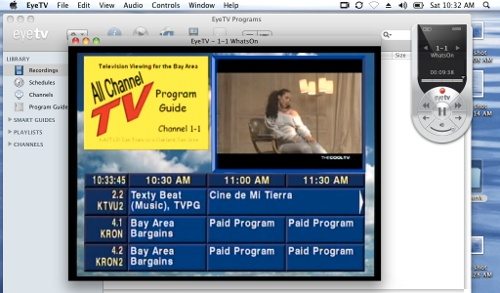
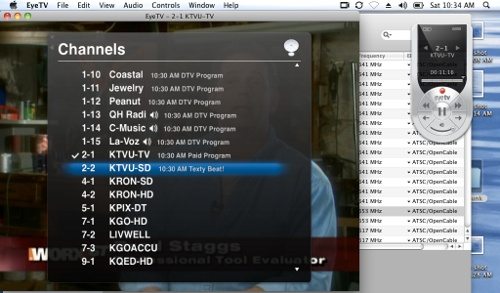
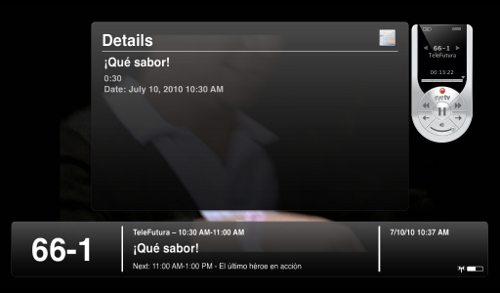
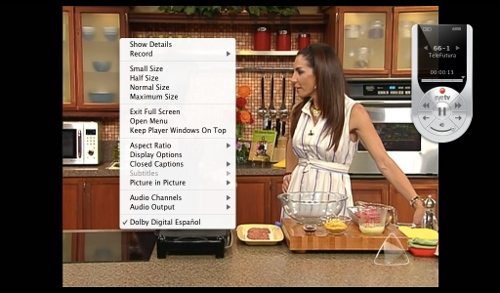



Gadgeteer Comment Policy - Please read before commenting
I’ve had two elgato Eye TV products over the years.
In each case I was trying to watch cable TV on my laptop computer.
The first product was just awful. So many wires and adaptors I felt like a character out of Terry Gilliam’s movie Brazil.
It was just too damn difficult to use.
The second product was almost exactly like the first in terms of wires, but it looked a little better.
Sadly I never got to enjoy a single program from start to finish as weird screen artifacts and interference would creep into the picture.
I finally posted a comment on the elgato forum. I was told that running the product on my puny laptop was the problem and I would have to spring for their more expensive and less convenient version with boosters built in.
I junked the entire system.
elgato is a company whose time was way back in the 90s and they never moved ahead with the times.
And their customer support sucked.
I wouldn’t give them my money. I wouldn’t even give them any time to set up the damn thing.
Hi Sandee, thanks for the feedback. You know, I feel your pain – I’ve used a lot of TV tuner/capture cards in the past myself that were twitchy to set up, and had marginal results at best even if you could get them to work.
This one is pretty much “screw the coax cable on, insert USB cable” and you’re done, so it seems like it passes the “not a scene from Brazil” test!
If you have a digital signal (OTA or Cable/Clear QAM) then the dongles (and your computer) don’t have to do a whole lot of work to encode video, so the results (even on low end gear) is quite good. I’m speaking in general of all digital TV tuners, elgato’s being no different than the others in that regard.
You mentioned at the start of your review that you also tested it out on a netbook. How did that go?
I’m still looking for one that works with a smaller CPU (DualCore 1.3) and doesn’t take a minute to switch channels…
ButchV, I used the acer aspire one D250 w/2gb ram and a 320gb 7200rpm drive (Atom 1.6ghz) running Windows 7 ultimate/Windows Media Center – for DTV/HDTV it worked fine for both live play and timeshifting/recording.
Lipman, I sure didn’t see a minute between channel changes. It’s not as fast as back in the analog days, sure, but I’d say we’re talking a second or so, max, to flip channels.
My test rigs were an Atom @ 1.6ghz, and a core 2 duo @ 2.2ghz. Your 1.3ghz cpu might be at the the low end for video encoding/recording (non-digital sources.) It should be OK for digital sources – if playback is an issue it could be more a problem with your video card.
I’ll just have to try one then, I suppose, maybe in a friendly shop. Video card should be fine, I can watch HD files without problems. Some time ago I asked six or seven major producers of external TV tuners for a recommendation from among their products and listed the details of my laptop – didn’t get a single response.
Really Nice article John!
I’ve been following Elgato’s EyeTV evolution for over 3 years now — waiting for it to become more stable and for it to become easier to install and use (MAC and PC). I think it’s made the progress I’ve wanted and I now look forward to hooking up with it later this year. ツ
All the best to you and your readers.
Steven Hotelling
My wife is remodeling the kitchen. Removal of a cupboard will create a space for a wall mounted 27″ iMac. My requirement TV, hers internet (well, mine too). I have cableservice in the kitchen already but don’t want to have the clutter of a cablebox; essentially just the BIG screen. So I will compromise to unencoded channels (100+). This removes the EyeTV HD as an option leaving the Hybrid or EyeTV 250 Plus. Any opinions or suggestions are welcome. Does the 250 + also have the cable connection? Not visible on the box and retailers will not open the box for me to have a look!
considering buying one for my macbook pro 2.4 core2
how does this hybrid compare to the 250/250 plus? which is latest technology?
do you need extra antenna (ole rabbit ears or digital specific?)
Just wanted to say thanks for the great review. I stumbled upon the EyeTV Hybrid while doing some research and your review was one of the first that popped up. Not knowing much about the product, I found what you had to say especially useful. Thank you for all of the work that you put into the website. I look forward to referring to it more in the future.
Hi,
Does anyone know about recording on a cruise ship TV? I will need to record a program that took place earlier on the ship and that they will record and later broadcast to the cabin TVs. Any insights will be most appreciated!
If you can get at the cable going to the TV, and plug it into the EyeTV, and you know what “channel” it’s on – its likely that there would be no issue. I have no idea how the TVs are wired up. I would think you could get/buy a copy of whatever they show on-ship – ask your purser…
Thanks for your comments, John. I already know we won’t be able to get it through the ship personnel, and I won’t know what interfaces the TV has till I’m on the ship. We’ll see what Best Buy says about returning it if it doesn’t work.
This review NEVER covered RECORDING!!!! Which is what makes this device valuable. You only covered VEIWING! How do you use it as a recorder a DVR. Anyone can figure how to plug it in, but how does it work as a RECORDER? Where do you store the programs you record, do you need additional software to record, is it included in the software that is supplied.
“EyeTV 3 DVR
The EyeTV 3 software is a full featured DVR, with built in program guide, scheduler, series recorder, and timeshifting/pausing live TV. It performed as expected during the review. “
I was interested to read the scathing comments by Sandee. I just fail to understand her disappointment, especially the comments about so many wires and adapters.
This tuner is a small USB device that plugs straight into the computer. The arial is plugged into the device. That’s it!
I have an EyeTV and it is absolutely fantastic. I never watch live television. I just schedule the device and then watch shows at my leisure. Great quality, too!
Hi,
Meationed in the specs are analouge reception. From which sources? Our cable provider still pumps analog down co-ax and we use a normal analog TV tuner for, well, tuning it in;P We don’t get DVB-C. Does this unit _really_ accept TV analog sources from the coax cable?
Thanks!
Yep, if you still have it – we had a handful back when I wrote this review – now long gone thanks to comcast’s digital upgrade. But it did work at the time.